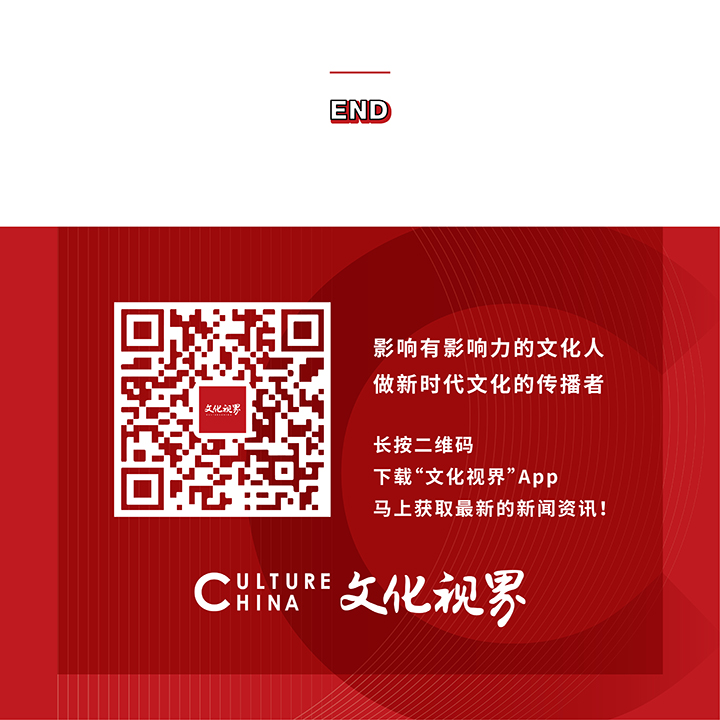

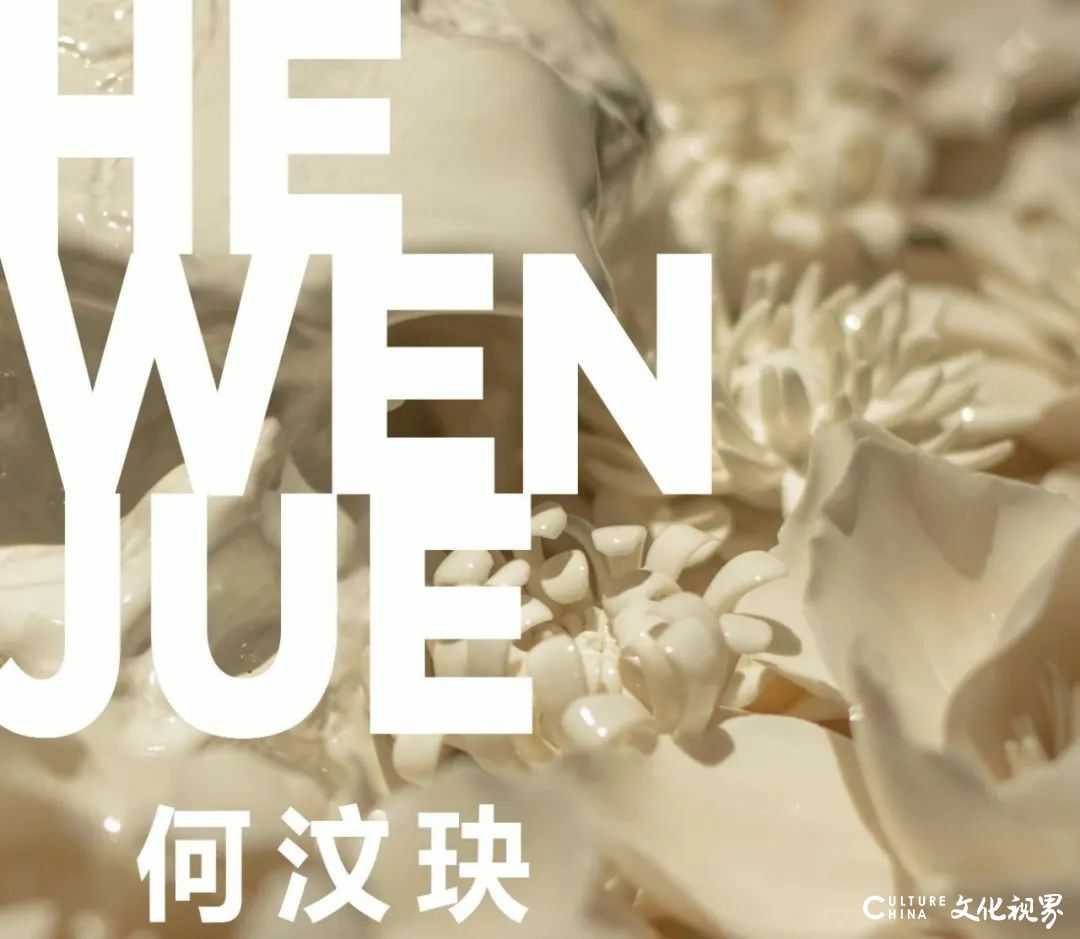
何汶玦个展
He Wenjue Solo Exhibition
展期
Duration
2024.6.15 - 2024.7.14
地点
Venue
芳草地画廊
Parkview Green Art
北京市朝阳区东大路9号
侨福芳草地B座LG2-K-14 (100020)
No. K-14, LG2 Floor, B Tower,
Parkview Green FangCaoDi,
No. 9 Dongdaqiao Road,
Chaoyang District, Beijing, China (100020)
目前,“何汶玦个展”正在北京市芳草地画廊举办,展期至7月14日。围绕展览的陶瓷作品、创作的灵感、创作的初衷、材料的选取等问题,芳草地画廊与艺术家何汶玦展开了一场对话。
采访者:芳草地画廊
艺术家:何汶玦
采访者:您会在创作中关注从平面语言到雕塑语言的转换吗?比如像《金木水火土》这一系列,它其实更像是画,是吧?挂在墙上,让人们的视线水平地去欣赏它。您对不同作品的主题的呈现形式有什么样的考量?什么主题适合立体呈现?什么主题适合平面?
In your creative process did you focus on the shift from painterly language to sculptural one? For examples the works belonging to “The Five Elements” series display similarities with painting. If installed on a wall, people will contemplate the works of this series at the eye level. What do you think about different expressive forms for specific subject matters? What kind of themes are more suitable for three- dimensional works and what kind of subject matters are better for paintings?
何汶玦:我会想到中国的一些传统文化,比如:金木水火土。但金木水火土应该怎么表达呢?我先上网搜索一些资料,比如说金,它就画了个三角形;水,可以画几个波浪。哦,那我就知道了,我知道怎么去创作了。首先是在大的方向上,正确的道路上,那我就开始自行创作。它给你这个考题了,那我就去想象了。这些元素在传统上是存在的,但是要去想象,去思考,不能依葫芦画瓢,那就搞不好。所以这组作品是基于五行的一种图像上的表达。
I have been taken into consideration some elements of Chinese traditional culture. For example, in “The Five Elements”, how should I represent metal, wood, water, fire and earth? I have been doing research on the Internet and I found out that metal for example is represented by a triangle, water by several waves. To set the direction and the right path is the starting point for the creation. This information inspired me but then I had to image how to represent it. Those elements are commonly used in traditional Chinese culture but then I had to find a way to re-elaborate them: it doesn’t work if you follow the original representation. So this series of works is based on some visual representation of the five elements.

△ 金木水火土 Gold, 2016
瓷 Porcelain,
51 × 45 × 8 cm × 5pcs
采访者:对于创作主题的选择上您是有一个规划吗?还是说很随机的?
In terms of selection of subject matter, do you plan it before or is it a casual decision?
何汶玦:没有,就是很随机的。比如:《梁山伯与祝英台》,虽然它是一个美好的爱情故事,但其实它也是关于死亡的一个题材,是陶瓷,平面的,挂起来很大,很漂亮。有上千只蝴蝶。我当时在景德镇喝咖啡嘛,我突然看到一个蝴蝶落户在窗口上,我马上就想做它了。还有《死了都要爱》这件作品,就是我在餐厅吃饭时,看到有个人拿着一个盒子,盒子里面装满了玫瑰,花上面有一个“爱”字。我看到后觉得有点意思,便想着怎么把它转化成作品。于是我吃完饭,回到工作室后马上就画了几张草图。玫瑰我没有用红色的,感觉很俗气。感觉对了,马上开始制作。
I don’t really plan it, it is rather casual. For example, even if “Liang Shanbo and Zhu Yingtai” tells a beautiful love story, it also addresses issues related to death. It is made of ceramic but also painting: composed by more than 1000 butterflies, once hang on the wall, is very big and beautiful. At that time, I was sitting in a cafeteria in Jingdezhen when I suddenly noticed a butterfly by the window and I immediately wanted to represent it. In the case of the work “Love to Death”, I was eating in a restaurant when I saw a man with a box full of roses with the character of “Love” on them. I found it very interesting and I started to think how I could have turned into a work of art. After the meal, I went back to my studio to work on a few sketches. I did not represent red roses as I found them rather vulgar. I choose white color instead as it is related to the theme of death. Once I felt the right mood, I started to work on the creation.
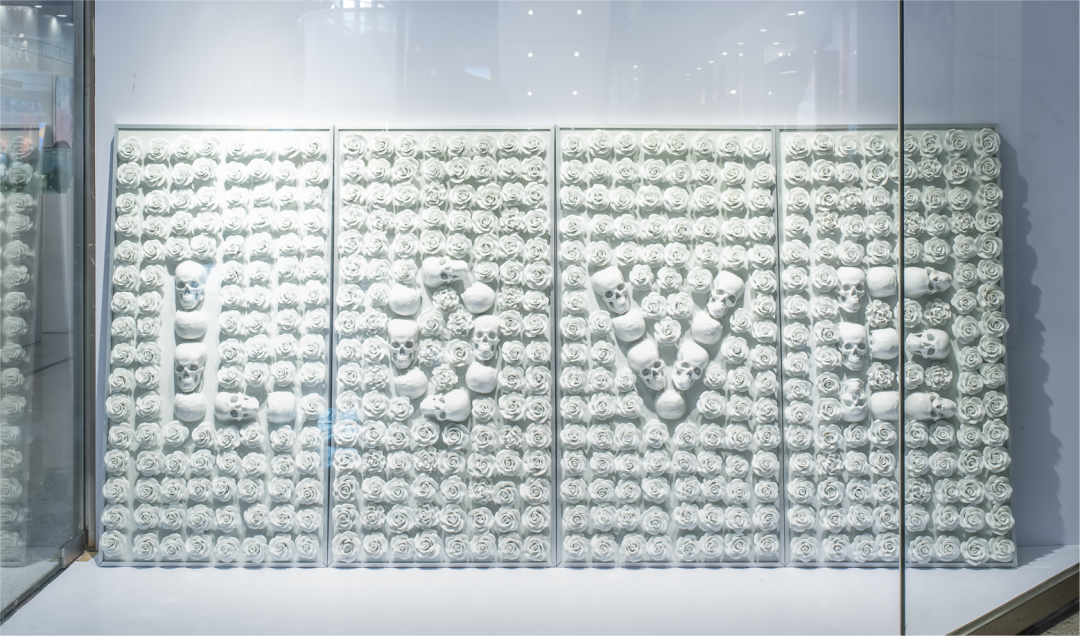
△ 死了都要爱 Love & Death, 2014-2015
瓷 Porcelain,
210 × 108 × 12cm
采访者:您说《黄金年代》是关于欲望的,请问这件作品的创作灵感是怎么来的呢?
“Golden Age” addresses issues related to lust: where did you find the inspiration for this work?
何汶玦:作为艺术家,灵感就是你在生活,在感受啊。
As an artist, inspiration comes from feelings and emotions of real life.
采访者:比如刚刚您说到:您无意间看见一个盒子,里边有花,您的灵感就来了。那对于这件作品呢?
As for the previous work, you mentioned that a box of flowers gave you inspiration. So what inspired you for this work about lust?
何汶玦:那就是谈恋爱啊。
I think it was falling in love.
采访者:可是这组作品的呈现形式是抽象的。您为什么不把它做得更写实些?反而用一种比较抽象的方式?
The expressive form of this group of work is abstract? Why didn’t you chose a more realistic form?
何汶玦:那就太直白了!我为什么给这组作品起名叫《黄金年代》,因为它代表的是一个物欲横流的社会。生活中很多东西都是跟物质挂钩的,所以人们会联想到黄金的东西。金色,它是有力量的。艺术家一定要把生活抽象化,然后表现出来。
It would have been too straightforward. I titled it “Golden Age” as it represents a society characterized by materialism. Many things in life are linked to materialism so people will think about gold and its power. Artists should be good at extracting elements from the real-life and then representing them in an abstract form.
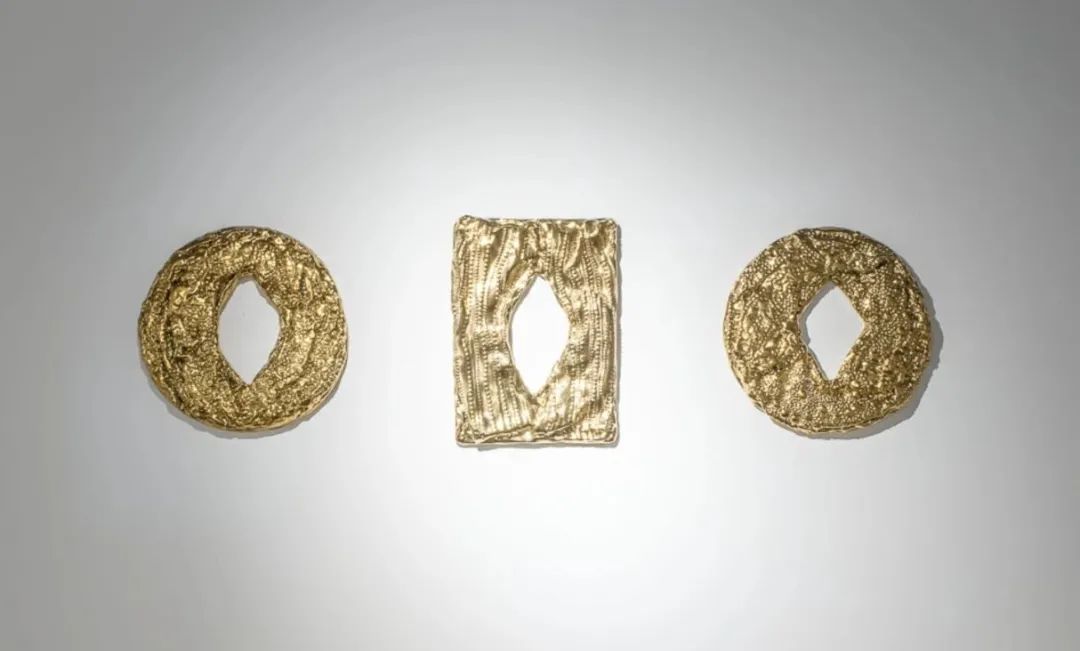
△ 黄金时代 Golden Age, 2016
镀金陶瓷 Ceramic Gold Plated,
38.5×38×3cm; 48×21×4cm; 38.5×38×3cm
采访者:所以这件作品里面是有一些权利与欲望的隐喻在。
So this work encompasses metaphors of power and lust.
何汶玦:对,黄金代表权利,中间的黑洞代表欲望。
Yes, gold represents power and the black holes represent lust.
采访者:在您看来,怎么样算是一件合格的作品呢?
How would you define a high-quality work of art?
何汶玦:就是我自己的一种感觉。漂亮它不是绝对的标准,这取决于人怎么看。有人认为古朴的东西漂亮;有人觉得鲜艳的东西漂亮。每个人都不一样,它没有一个标准概念。就拿陶瓷来说,在烧之前它是一块泥巴,烧出来之后它会让你惊艳,怎么是这样的!它会有一部分是你想象不到的。所以我特别期待开窑,它就让我有一种特别的想象。这就是陶瓷,它会有很多让你感到意外的东西。
It's just my own feeling. Beauty doesn’t have absolute standards, it depends on how people see it. Some people think simple things are beautiful; other people think bright things are beautiful. Everyone is different and there are no standardized concepts. Take ceramics as an example. Before the firing process, it is just a piece of mud. After the firing process, it will amaze you. Why is it like this! There are things beyond our imagination. So, each time I look forward to opening the kiln and see how it looks like, it nurtures my imagination. This is ceramic, where there's a whole world of unexpected surprises.
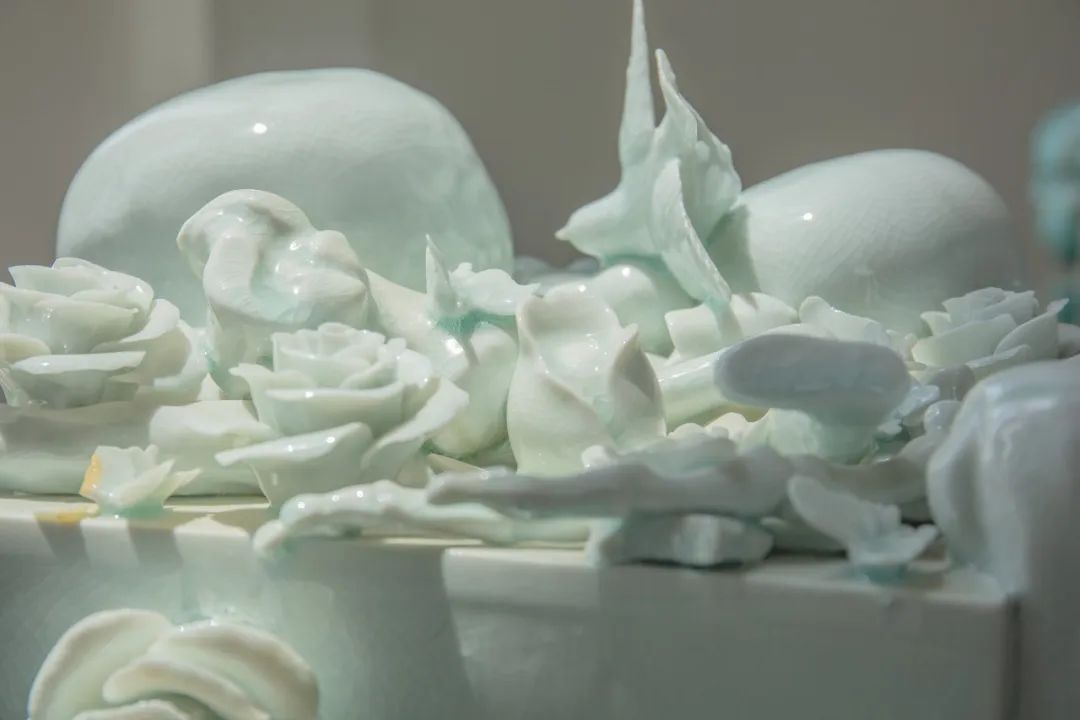
△ 丰碑 Monunment, 2014-2015
瓷 Porcelain,
36 × 36 × 94cm
采访者:嗯,这就是陶瓷特殊的地方,有一种未知性。
This unpredictability makes ceramic a very charming material.
何汶玦:对,未知性。
Yes, the realm of the unknown.
采访者:《百财》的创作灵感是来自台北故宫的那件“翡翠白菜”吗?
Did the inspiration for “Gathering Wealth” come from the Jadeite Cabbage displayed at the Taipei National Palace Museum?
何汶玦:对,因为我去台北故宫,看到那颗白菜时,有无数人正围着看,我就有一种创作的冲动。用翡翠或是玉,我又做不起。用陶瓷感觉又不对,所以就想到用琉璃,在古代,白菜寓意百财,我就做了一百颗。
Yes, when I went to Taipei National Palace Museum, I saw the Jadeite Cabbage surrounded by many visitors: I got an urge to create. I couldn’t afford to use jade or jadeite and I felt that ceramic is not the right material. I decided to use coloured glaze and to make 100 cabbage to highlight the metaphorical allegory with the homophonic character of gathering wealth.
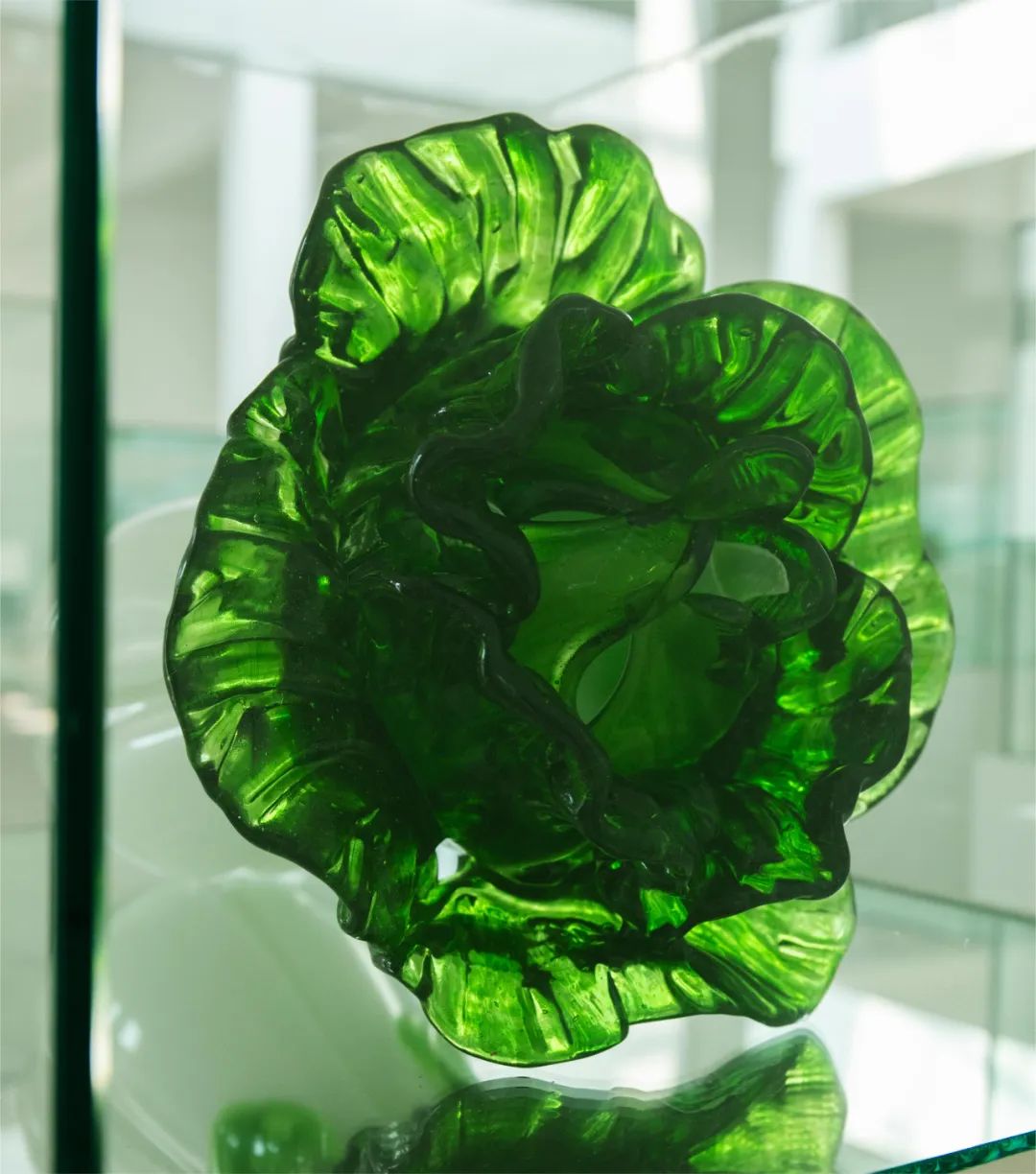
△ 百财 Bai Cai, 2012-2015
琉璃 Coloured Glaze
采访者:所以您的创作线索都是基于一些偶发的灵感,是吗?
So your creative cues are based on episodic inspiration, right?
何汶玦:对,偶发。但它还是有主题,有线索。就是你人生的一个经历,你的学识,你看的东西,它会串联起来,这些都是自然而然的。
Yes, it can be said that most of the time it jumped out randomly, however there is a thematic coherence. Naturally creation is influenced by personal life experience and by what you learn and study.
采访者:那能谈谈当下您最想要创作的主题吗?
Could you share with us subject matters that you would like to work on lately?
何汶玦:其实,我人生最大的理想还不只是艺术创作。我有一个理想国,这个理想国是我毕生追求的,它就是我对古代艺术品收藏的痴迷。我非常想把我收藏的东西和我的绘画结合起来做一个展览,可惜我一直没有找到这么一个机会。
In fact, my greatest dream in life is not just artistic creation. I have an utopia that I have been pursuing all my life. It is my obsession with collecting ancient art. I would very much like to do an exhibition integrating my collections with my painting, but unfortunately I still haven’t found the right opportunity.
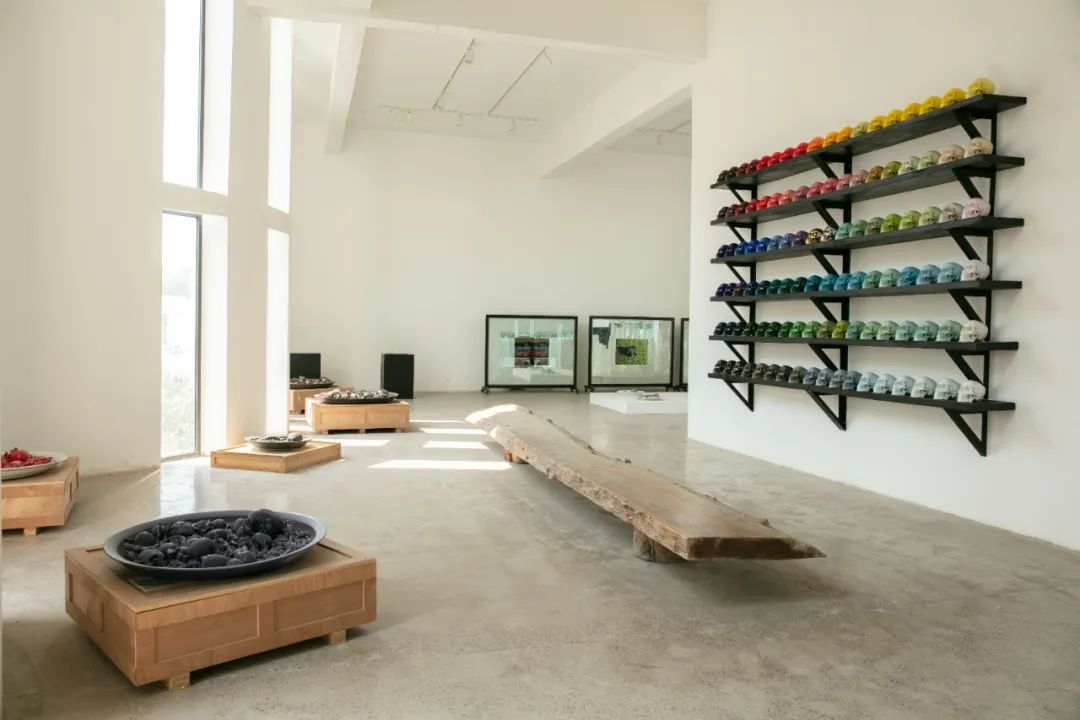
艺术家工作室 © 何汶玦
Artist's studio © He Wenjue
采访者:您收藏了哪些器物呢?都是陶瓷吗?
What kind of objects do you collect? Just ceramics?
何汶玦:陶瓷也有,陶瓷是最少的。最多的是玉器。古代玉器,新石器时代的玉器,比如玉琮、玉璧、夏商周的青铜器等。
I do have some ceramics, but mainly are jade objects. Ancient jade, jade from the Neolithic Age, such as cong and bi and bronzes from the Xia, Shang and Zhou dynasties, etc.
采访者:您收藏大概有多长时间了?
How long have you been collecting for?
何汶玦:几十年了,但我的家族从晚清就开始收藏了。
Few decades, but my family started collecting since the late Qing dynasty.
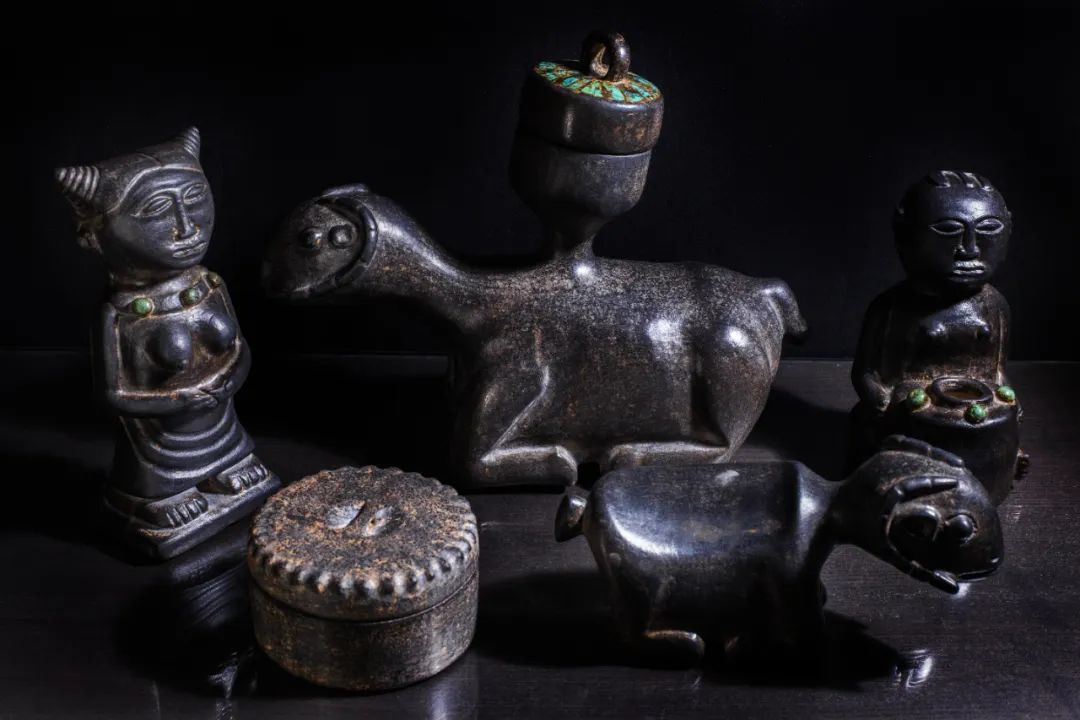
艺术家工作室 © 何汶玦
Artist's studio © He Wenjue
采访者:那您的收藏对您的创作有一些影响吗?
Did the collection exert an influence in your creations?
何汶玦:没有影响,完全没有关系。它是我另外的一条思路。
Absolutely not, they are two different things for me.
采访者:您大概有多少件藏品?
How many pieces do you have roughly in your collection?
何汶玦:大概有几千件。我目前就想做这么一个我的收藏和作品结合的展览,全新的一个系列,它是一个综合材料的创作。
Probably several thousand pieces. I currently want to do an exhibition combining pieces from my collection and my works. It is a new series of works in different materials.
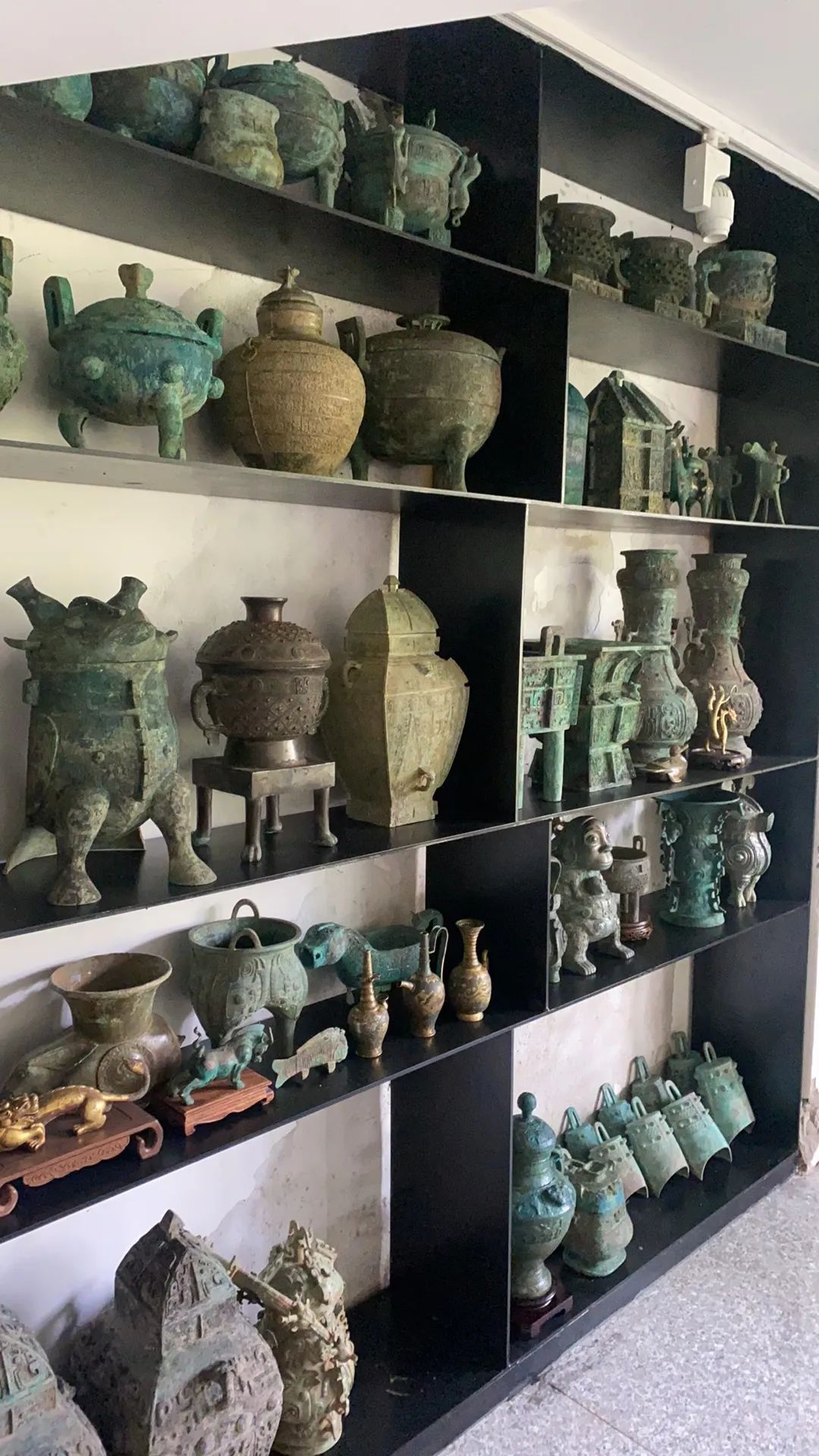
艺术家工作室 © 何汶玦
Artist's studio © He Wenjue
采访者:您会直接拿那些古代器物来创作吗?
Would you like to incorporate these ancient artifacts in your works?
何汶玦:这个可能不会。我还是会拿现代的材料来创作。这个展览相当于一个结合我个人藏品以及围绕这些藏品创作的一些新作品的艺术展。
I don’t think so. I will still use modern materials. This exhibition should include pieces of my personal collection and new works created around them.
采访者:期待您这个新项目能早日落成,非常感谢您接受我们的采访。
We are looking forward to seeing this project. Thank you very much for this interview.
何汶玦:谢谢你们的邀请。
Thank you for the invitation.
(来源:芳草地画廊)
艺术家简介
About the Artist
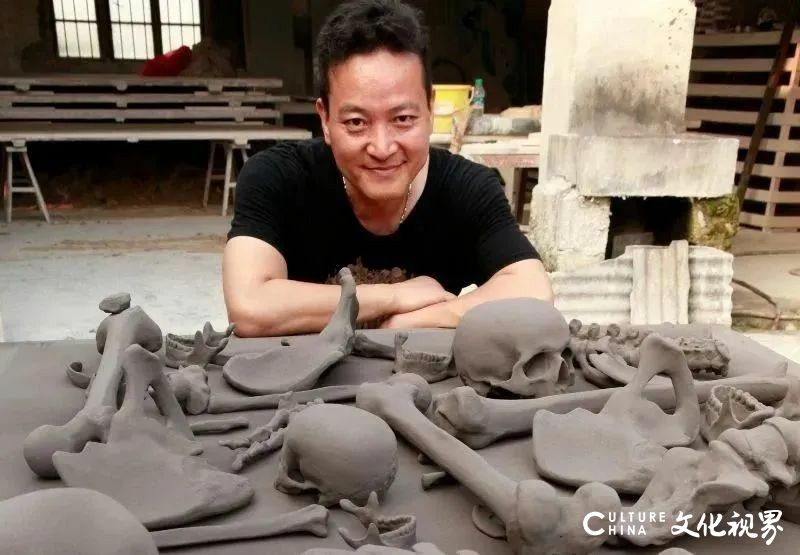
何汶玦
1970 出生于中国湖南
1989-1993 深圳大学现代艺术学士
1994-1997 中央美术学院第九届油画高研班
2003-2006 吉林艺术学院绘画硕士
He Wenjue
1970 Born in Hunan, China
1989-1993 Bachelor of Modern Art, Shenzhen University
1994-1997 The 9th Oil Painting Advanced Research Program of the Central Academy of Fine Arts
2003-2006 Master of Painting, Jilin University of Arts
湖南省油画学会副主席,中国美术家协会会员,中国油画家学会会员。何汶玦的艺术与当下时代风潮紧密结合,却弥漫着一股个性的特征。他的创作以一种艺术贴近世俗生活的姿态,却总能将我们从所能看见和认可到的世界,引领到了一个掩藏的不可预知的广袤空间。他的作品在中国以及印度尼西亚、西班牙、意大利、韩国、德国、比利时、奥地利、马来西亚、美国、瑞士、法国和英国等国家的许多机构展出。作品公共收藏于中国以及比利时、印度尼西亚、瑞士、西班牙等多家重要美术馆。
He is currently the vice president of Hunan Oil Painting Society, a member of China Artists Association and a member of China Oil Painting Society. He Wenjue’s art, while reflecting contemporary society, is also characterized by a unique and personal style. His creations bring art close to life, while guiding the viewers from a familiar and recognizable dimension to a hidden and unpredictable vast space. His works have been displayed in many institutions both in China and in other countries including Indonesia, Spain, Italy, South Korea, Germany, Belgium, Austria, Malasia, US, Switzerland, France and UK. His works are collected by Museums in China and abroad including Belgium, Indonesia, Switzerland, Spain, etc.
